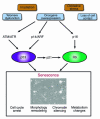When cells get stressed: an integrative view of cellular senescence
- PMID: 14702100
- PMCID: PMC300889
- DOI: 10.1172/JCI20663
When cells get stressed: an integrative view of cellular senescence
Abstract
Cells entering a state of senescence undergo a permanent cell cycle arrest, accompanied by a set of functional and morphological changes. Senescence of cells occurs following an extended period of proliferation in culture or in response to various physiologic stresses, yet little is known about the role this phenomenon plays in vivo. The study of senescence has focused largely on its hypothesized role as a barrier to extended cell division, governed by a division-counting mechanism in the form of telomere length. Here, we discuss the biological functions of cellular senescence and suggest that it should be viewed in terms of its role as a general cellular stress response program, rather than strictly as a barrier to unlimited cycles of cell growth and division. We also discuss the relative roles played by telomere shortening and telomere uncapping in the induction of senescence.
Figures


References
-
- Hayflick L, Moorhead PS. The serial cultivation of human diploid cell strains. Exp. Cell Res. 1961;25:585–621. - PubMed
-
- Campisi J. Cancer, aging and cellular senescence. In Vivo. 2000;14:183–188. - PubMed
-
- Sitte N, Merker K, Von Zglinicki T, Grune T, Davies KJ. Protein oxidation and degradation during cellular senescence of human BJ fibroblasts. I. Effects of proliferative senescence. FASEB J. 2000;14:2495–2502. - PubMed
-
- Narita M, et al. Rb-mediated heterochromatin formation and silencing of E2F target genes during cellular senescence. Cell. 2003;113:703–716. - PubMed
-
- Lloyd AC. Limits to lifespan. Nat. Cell Biol. 2002;4:E25–E27. - PubMed
Publication types
MeSH terms
LinkOut - more resources
Full Text Sources
Other Literature Sources

